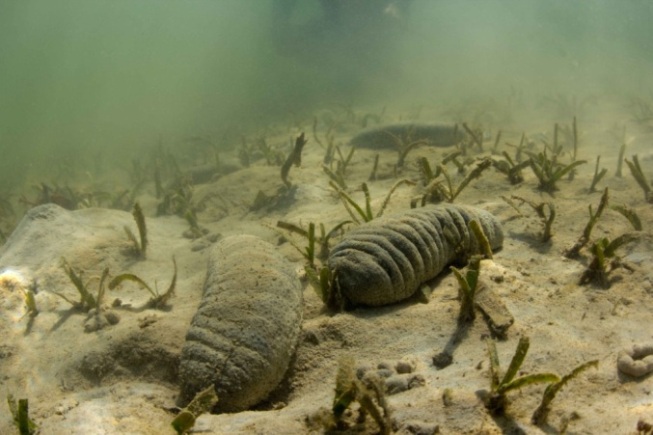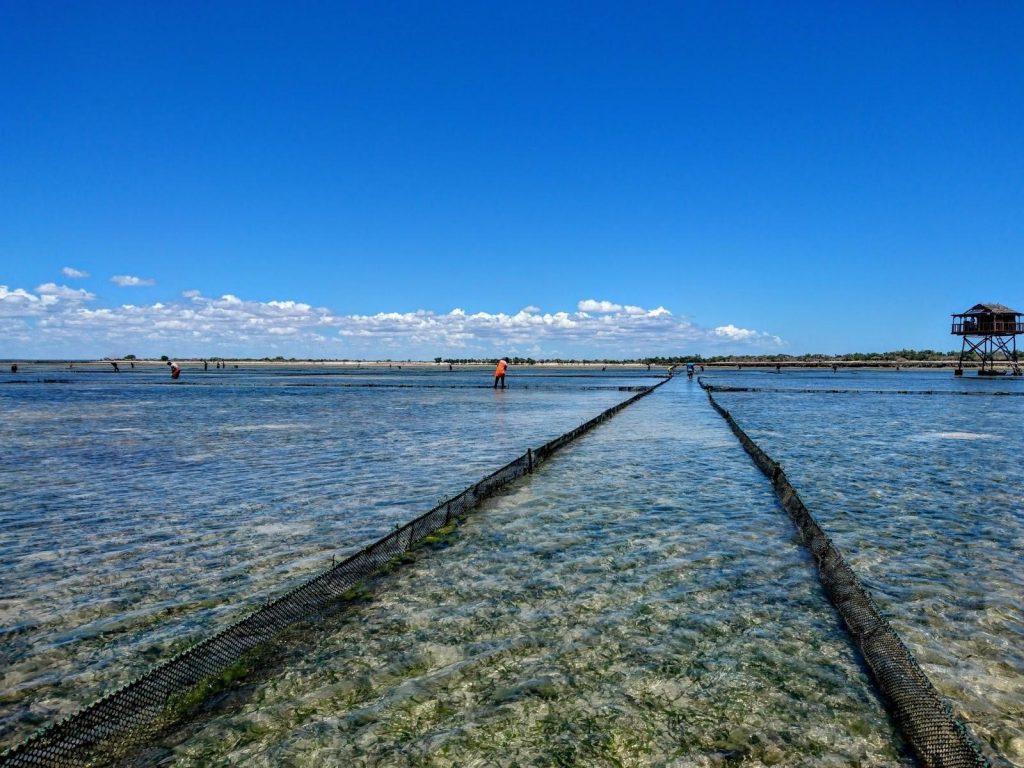Sea Cucumber
Sustained demand for sea cucumber products in Asian markets, especially in China, have provided a valuable source of income for coastal communities in the tropics. Sea cucumbers have primarily been harvested for a luxury dried food item known as beche-de-mar. ref However, recent declines of wild stock due to overfishing have led to an increased interest in sea cucumber farming to help meet demand, increase income security, and diversify livelihoods.
Culture Methods
The main methods for culturing sea cucumber include pond farming, pen culture, sea ranching, and tank culture. Stocking larger juveniles in pond farming, pen culture, and sea ranching usually results in a higher survival rate but this also means the cost of production at the nursery level will be more expensive. Generally, juveniles weighing over 20 g are no longer vulnerable to predators such as crabs. Once juveniles are placed in any of these farming methods, with the exception of tank culture, they do not usually require feeding as they can graze on algae and aquatic invertebrates on the seafloor. This grazing on substrate may also help improve water conditions. For all methods, stocking density needs to be less than 200 g/m². When density reaches more than about 200-250 g/m2, growth slows down or stops altogether.

Sea cucumbers inside pens, Tampolove. Photo © Garth Cripps/Blue Ventures
Pond Culture
Ponds are usually located near to the shore to facilitate water exchange (intertidal zone). Tides bring in fresh seawater and water flow is controlled by opening and closing sluice gates. ref Sea cucumber ponds can be former shrimp or crab ponds or newly built earthen ponds with sandy-muddy bottoms or coral-sand substrates. Sea cucumber can also be grown in rotation with shrimp, improving pond conditions by ingesting substrate and removing organic detritus.

Sea cucumbers ponds, Vietnam. Photo © David Mills (CC BY-NC-ND 2.0)
For tropical species, pond water depths are usually around 0.8 to 1.5 m. Sea cucumber can also be produced within multitrophic polyculture ponds (recycling of feeds and waste products). For example, in southern China Holothuria scabra are grown with pearl oysters and groupers in earthen ponds of several hundred hectares.
For temperate sea cucumber species, the ideal conditions for pond culture include: ref
- Be near to the low tide mark so that seawater can be fed into the pond by gravity
- Be in an area not affected by pollution
- Ocean salinity in the 28-31 range
- Have a sandy or sandy-muddy bottom
- Be at 2 m depth or more
- Have a pond size between 1 to 4 ha
- Have shelters to protect the cultured organisms against typhoons or strong wave attack
Preparing ponds for sea cucumber farming includes: drying the pond (using sluices and pumps), removing unwanted predators such as crabs, tilling the sediment to disturb the mud layer (at least 5 cm burial layer), building a net pen at the sluice-gates to exclude predators and prevent sea cucumber from escaping or aggregating in this area, applying lime (agriculture or hydrated) at a rate of 0.5-1.0 t/ha and filling the pond with seawater one week before stocking with juvenile sea cucumbers.
Some challenges with pond culture include heavy rain during the wet season as sea cucumber do not tolerate freshwater and intense heat during the dry season. Challenges can arise due to the relatively long duration of culture which can increase the expense of renting ponds and labor costs due to the high risk over the wet season.
Pen Culture
In pen culture, sea cucumbers can be hung in cages under wooden rafts or placed in pens on the seafloor. ref Pens are often constructed from locally available materials, including nylon fishing nets, wooden stakes, and rope. The nets are held in place by iron rebar which is buried into the sediment. ref Nets or mesh are used to delimit the enclosures and allow water exchange but also to prevent the sea cucumbers from getting out of and to reduce attacks from predators.
Some optimal conditions for pen culture include:
- Placing pens in a sheltered area protected from high energy waves
- Ensuring pens always have water coverage even at low water springs
- Being accessible by foot during spring low tide
- Having significant tidal inflow of settleable solids
- Having sediment that consists of fine sand
- Being at least 15 cm of sediment above the rock below
- Placing pens away from areas with a high density human population
- Placing pens in areas that have been agreed for use by the area’s local resource users
- Being in an area easily patrolled by security guards at night.
Pens can be either circular or square. Circular pens are more resistant to currents and require less material than square pens to construct, making them a cheaper option. Square pens are better for optimizing space and facilitating spatial planning. ref Small internal covered pens are used as nurseries at sites which suffer from high levels of predation. Pens also require regular maintenance, such as the removal of predators, including crabs, and removing seaweed or mud from the nets to ensure good water exchange.
In Madagascar, a buffer zone marked by buoys where fishing is prohibited surrounds sea cucumber pens. To ensure the safety of the stock, watchtowers are built at strategic points on the farm where people approaching the farm can be seen, but also where there is a good view of the larger part of the farm. The watchtowers are also equipped with solar-powered torchlights to ensure the safety of the stocks during the night.

Sea cucumber pens from 2017, Tampolove. Photo © Timothy Klückow/Blue Ventures
Sea Ranching
Sea ranching involves releasing hatchery-produced juveniles into unenclosed marine environments and allowing them to grow naturally in these areas for later harvesting when they reach a marketable size. Some site selection criteria for determining good sea ranching locations include:
- Location: Sites that are not vulnerable to wind, waves, and currents; Have some form of security against natural predators and human thieves; Are accessible and allow for easy transportation to both the hatchery and market.
- Bio-physical: Sites that are within the correct temperature and salinity range; Have good ecosystem health including having existing wild sea cucumbers and seagrass; Have substrate that is the right quality for sea cucumbers (sandy, muddy, coral rubble); Water quality is high.
- Social and governance: Have rights to the site as well as community and government support.
Different zones are delimited for sea ranching release, including the core zone, where the juveniles are released, and a buffer zone around it where fishing is prohibited. These zones are differentiated by the use of buoys. This type of culture requires the least amount of labor for upkeep, but stock survival will be considerably lower than pen or pond culture. Additionally, property rights of sea cucumber in sea ranching is not well defined, so poaching is a key concern. ref
This page was developed collaboratively with Hery Lova Razafimamonjiraibe, Blue Ventures.
